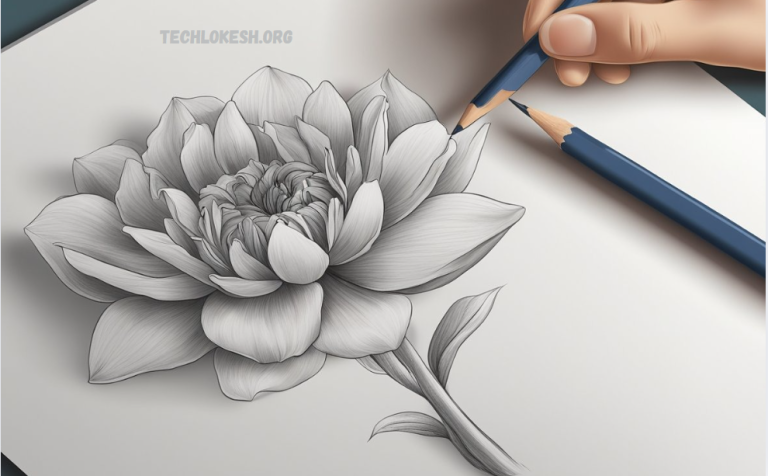Drawing stunning flower illustrations is not only a source of joy but also an excellent way to enhance your Creativity. Whether you’re a complete novice or someone looking to refine your skills, this beginner’s guide is your perfect bouquet of inspiration.
We’ll explore essential techniques, from mastering basic shapes to adding intricate details that bring your flowers to life. With a bit of practice and the right tips, you’ll soon transform blank spaces into vibrant gardens filled with color and life.
Get ready to pick up your pencils and dive into the enchanting world of floral art, where every stroke is a step towards creating breathtaking masterpieces. Join us to cultivate your artistic abilities and watch as your drawings flourish like the flowers you aim to depict!
Understanding Flower Anatomy
Before delving into the world of flower illustrations, it is crucial to grasp the fundamental anatomy of flowers. Flowers come in various shapes, sizes, and structures, and being familiar with their anatomy will significantly enhance your ability to replicate them accurately on paper. The primary parts of a flower include the petals, sepals, stamens, and pistils. Petals are the colorful parts that attract pollinators and give the flower its unique appearance. Sepals are green, leaf-like structures that protect the flower bud as it develops before it opens. Reproductive parts consist of anthers and filaments, while reproductive parts include the stigma, style, and ovary.
Understanding the arrangement and function of these parts will help you draw flowers that look natural and lifelike. For example, knowing that petals often overlap in a specific pattern can guide you in sketching them accurately. Similarly, recognizing the symmetry in flowers like lilies or the radial arrangement in sunflowers can inform your drawing process. It’s also helpful to study the variations in flower anatomy across different species, as this knowledge allows you to understand the unique characteristics of each type of flower you wish to illustrate.
Essential Drawing Tools and Materials
To create stunning flower illustrations, having the right tools and materials is crucial. While you don’t need an extensive collection of art supplies, investing in a few high-quality items can make a significant difference in your work. The basics include a selection of pencils, erasers, paper, and possibly some colored pencils or watercolors for adding color.
Graphite pencils, from hard (H) to soft (B) grades. Hard pencils (like 2H or 4H) are great for light, precise lines, while soft pencils (like 2B or 4B) are ideal for shading and creating darker lines. A good quality eraser, such as a kneaded eraser, is essential for making corrections and lifting graphite without damaging the paper.
In addition to these basics, consider having a few specialty tools to enhance your flower illustrations. Fine-tipped pens or markers can be used for adding detailed linework and outlines. A blending stump, also known as a tortillon, is helpful in smoothing out pencil shading and creating soft, seamless gradients. If you enjoy working with color, a set of colored pencils, watercolors, or even markers can bring your flower drawings to life. Experimenting with different mediums will help you discover which tools best suit your style and preferences.
Basic Techniques for Drawing Flowers
Mastering basic drawing techniques is the foundation for creating beautiful flower illustrations. One of the first techniques to learn is how to draw simple shapes, as most flowers can be broken into geometric forms such as circles, ovals, and triangles. These shapes serve as a framework for your drawing, helping you to accurately proportion and position the different parts of the flower.
Begin by lightly sketching the overall shape of the flower with a hard pencil. For example, a rose can be represented with a series of concentric circles to depict the layers of petals. At the same time, a daisy might start with a central circle for the disc and elongated ovals for the petals. Once you have the basic shapes in place, you can begin to refine them into more detailed forms. Please pay attention to the natural curves and angles of the petals and adjust your lines accordingly to capture their unique appearance.
Shading is another essential technique for adding depth and dimension to your flower illustrations. Start by drawing and shading the areas that would be in shadow. Use smooth, controlled strokes to gradually build up layers of shading. Using blending tools, such as a blending stump or your finger, can help create smooth transitions between light and dark areas.
Read Also: Mastering PicsArt – A Step-by-Step Guide to Editing Alone Style Photos with a Bold Red Background
Step-by-Step Guide to Drawing Popular Flowers
Drawing popular flowers can be a rewarding way to practice and refine your skills. Let’s start with a classic favorite: the rose. Begin by sketching a small oval or circle for the center of the rose. From there, draw a series of curved lines radiating outward, representing the layers of petals. Roses have a spiral pattern, so ensure the petals overlap naturally. Gradually add more petals, making them larger as you move outward from the center. Once the basic structure is in place, refine the shape of each petal and add details like the veins and folds.
Next, let’s move on to daisies, which are simpler in structure but equally beautiful. Start with a central circle for the disc of the daisy. Then, draw a series of elongated ovals around the circle to represent the petals. Daisies typically have many petals, so fill in the space evenly, ensuring they radiate outward from the center. Add details to the petals, such as subtle curves and slight variations in length and width. Finally, add texture to the center of the daisy with small dots or cross-hatching to give it a realistic appearance.
Sunflowers are another popular choice, offering an excellent opportunity to practice drawing large, bold flowers. Begin with a large circle for the center of the sunflower. Around this circle, draw a series of petal shapes, making sure they are long and pointed. Sunflowers have many petals, so overlap them slightly and vary their size and direction to create a natural look. Once the petals are in place, add details like the texture of the seeds in the center and the rough edges of the petals. You can also add a few leaves and a stem to complete the drawing.
Color Theory for Flower Illustrations
Adding color to your flower illustrations can elevate them from simple sketches to vibrant works of art. Selecting the right colors and creating visually harmonious compositions. Understanding the relationships between different colors. It consists of primary colors (red, blue, yellow), secondary colors (green, orange, purple), and tertiary colors (combinations of primary and secondary colors).
When coloring your flower illustrations, consider the color schemes that will best enhance your work. Complementary colors—such as red and green or blue and orange—create a striking contrast that can make your flowers stand out. Analogous colors—such as blue-green and green—create a more harmonious and soothing effect.
In addition to choosing the right colors, consider the value and saturation of the colors you use. Value refers to the lightness or darkness of a color, while saturation refers to the intensity or purity of a color. Using a range of values can add depth and dimension to your illustrations. For example, adding lighter values to the tips of the petals and darker values to the base can create a sense of volume, making the petals appear more three-dimensional. Similarly, using more saturated colors for the main parts of the flower and desaturated colors for the background can help the flower stand out.
Frequently Asked Questions
What is Blooming Creativity, and who is it for?
Blooming Creativity is a beginner-friendly guide that teaches aspiring artists how to draw beautiful flower illustrations step-by-step. It’s ideal for complete beginners or those looking to refine their botanical drawing skills.
Do I need any prior drawing experience to use this guide?
Not at all! The guide is tailored for absolute beginners, breaking down each flower into simple shapes and strokes that anyone can follow.
What materials do I need to start drawing?
You’ll need basic drawing tools such as a pencil, eraser, paper, and optional colored pencils or markers. The guide may also suggest some preferred brands for better results.
What types of flowers will I learn to draw?
The guide features a diverse array of popular flowers, including roses, tulips, daisies, sunflowers, peonies, and more — both simple and intricate types.
Does the book include colored illustrations or only black-and-white sketches?
Yes, it includes both! The step-by-step instructions are typically black and white to help you focus on form and line work, while full-color reference illustrations are provided for inspiration.
Conclusion
Blooming Creativity is more than just a drawing guide — it’s a gateway to discovering the artist within you. With its gentle step-by-step approach, accessible techniques, and beautifully illustrated examples, this book empowers beginners to create stunning floral art with confidence and joy. Whether you’re picking up a pencil for the first time or returning to a forgotten passion, Blooming Creativity invites you to slow down, observe nature’s details, and express yourself through every petal and leaf. By the end, you won’t just be drawing flowers — you’ll be growing your artistic voice.

